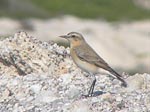|
|
 |
|
The Importance of Antikythira
So, every year during both migration periods (spring and fall) Antikythira are being used by a huge number of birds. Some of them just pass over, without stop, and others, after a long journey, spend a few hours to feed and rest. In spring, birds are coming from Western Crete or directly from the coasts of North Africa. From early March to mid June millions of small birds have passed over the island. Along with them, many waders and waterfowl are using the coasts or seasonal flooded fields inland to rest, while birds of prey pass in fluctuating numbers through all the season. In fall migration, things are quite different as birds are coming from Europe (mainly central and eastern). This time, however, along with the adults that passed in spring, 1st year birds follow. From the above data we can point out two features of Antikythira: this island is a very important migration site (more than 200 migrant species) especially for passerines and 5 breeding species are birds of prey, found in good numbers. All of these raptors have been seen feeding on birds, even the Kestrels.
Antikythira is one of the most important sites for the study of bird (raptors and passerines) migration in Greece. At the same time, it’s one of the few areas where one can so easily earn to identify a great number of bird species.
|
Latest posts from the ABO blog
|
|
|
 |

|

|

|

|
Personal Data Protection Policy
Copyright © 2024 Antikythira Bird Observatory (ABO), Hellenic Ornithological SocietyThemistokleous 80, GR-10681, Athens, Greece,
Tel/Fax: +30 210 8227937, +30 210 8228704,
e-mail: info@ornithologiki.gr
Fragkon 22, GR-54625, Thessaloniki, Greece
Tel/ Fax: +30 2310 244245,
e-mail: thess@ornithologiki.gr


